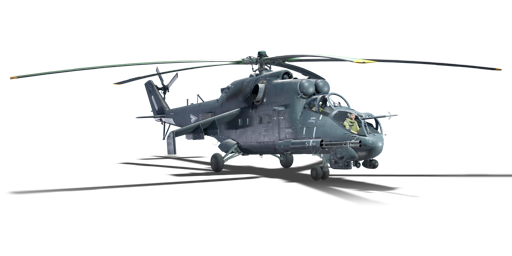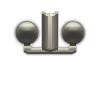




Hungary began to operate the Mi-24 in 1993 after receiving 20 Mi-24D/Vs as a gift from Germany. However, they realized that they were already obsolete by the time they were sent into service. An upgrade program was started to refit the Mi-24Ds and upgrade them to the Mi-24V and Mi-24P variant, which included the new GSh-30-2 fixed twin-barrel cannon, 9K114 Shturm (AT-6 "Spiral") radio-guided anti-armour missiles, integrated navigations and communications, and an English-language display/computer system.
It was introduced in Update "Sons of Attila". The Mi-24P is very similar to the Mi-24V, having the same airframe, technology, and weapons. The only difference is the gun armament: the chin-mounted Yak-B Gatling gun has been replaced with a fixed GSh-30-2 cannon mounted on the right side of the nose. This is the same type of cannon mounted on the Su-25 attack jet, another Soviet "flying tank". Although it is difficult to aim, a quick burst from the cannon can shred lightly armoured vehicles. Thus, the Mi-24P is a sidegrade to the Mi-24V, having more anti-ground ability at the cost of a minor amount of anti-air capability.
| Belt | Belt filling | Armor penetration (mm) at a distance: | |||||
|---|---|---|---|---|---|---|---|
| 10 m | 100 m | 500 m | 1000 m | 1500 m | 2000 m | ||
| HEFI-T/APHE | 47 | 46 | 39 | 32 | 26 | 21 | |
| AP-T/HEF-I/APHE/HEF-I | 62 | 60 | 51 | 42 | 35 | 29 | |
| AP-T/APHE/APHE | 62 | 60 | 51 | 42 | 35 | 29 | |
| APHE/HEF-I/HEF-I/HEFI-T | 47 | 46 | 39 | 32 | 26 | 21 | |
| APHE/HEF-I/HEF-I | 47 | 46 | 39 | 32 | 26 | 21 | |
| Name | Weight | Slot | ||||||
|---|---|---|---|---|---|---|---|---|
| 2 × | 93 kg |  |  |  |  | |||
| 43.5 kg |  |  | ||||||
| 2 × | 87 kg |  |  | |||||
| 44 kg |  |  | ||||||
| 2 × | 88 kg |  |  | |||||
| 20 × | 326 kg |  |  |  |  | |||
| 235 kg |  |  |  |  | ||||
| 250 kg |  |  |  |  | ||||
| 94.3 kg |  |  |  |  | ||||
| 2 × | 352.2 kg |  |  |  |  | |||
| 478 kg |  |  | ||||||







 2 x (50 / 290 / 430) %
2 x (50 / 290 / 430) % 
 2 x 214 %
2 x 214 % 

Flight performance |
|---|
Survivability |
|---|
Weaponry | |||
|---|---|---|---|